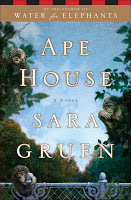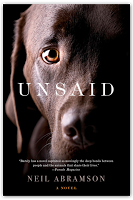 Isabel Duncan is a researcher at the Great Ape Language Lab and is beloved by her group of bonobos. Bonobos share 98.7% of their DNA with humans and we can generally understand their facial expressions and hand gestures. They have been taught sign language, how to communicate using a computer with lexigrams, and can understand and respond to spoken words and sentences. Another part of Isabel’s reality is the group of radical protesters outside her facility convinced that the apes are being cruelly treated. One fateful night the bonobos try to tell her that something is wrong and there is a stranger, but too late, there is a massive explosion and Isabel is seriously injured and the bonobos are kidnapped.
Isabel Duncan is a researcher at the Great Ape Language Lab and is beloved by her group of bonobos. Bonobos share 98.7% of their DNA with humans and we can generally understand their facial expressions and hand gestures. They have been taught sign language, how to communicate using a computer with lexigrams, and can understand and respond to spoken words and sentences. Another part of Isabel’s reality is the group of radical protesters outside her facility convinced that the apes are being cruelly treated. One fateful night the bonobos try to tell her that something is wrong and there is a stranger, but too late, there is a massive explosion and Isabel is seriously injured and the bonobos are kidnapped.
Reporter John Thigpen has made a connection with Isabel and the bonobos only to find himself run off the project by an unscrupulous colleague. John then finds himself unemployed with a wife who is going through a crisis of her own. He is offered a job by a sketchy tabloid newspaper with the assignment to cover the Ape House. The Ape House (M) by Sara Gruen is many things – moving, thought-provoking, heartbreaking and funny. In this novel the bad guys are oh so bad. The apes are kidnapped and put on display in a reality television inspired ape house. Here is human nature at its worst as these gentle and compassionate animals are goaded into behaving provocatively for profit. Their keepers introduce disruptive stimuli into their environment in the hopes of eliciting shocking and ratings boosting behavior. The apes prove themselves time and again to be more dignified and compassionate that the humans. I would like to have seen more of the bonobos in the novel, but the human story lines were a nice balance of drama and humour.
The Ape House (M) by Sara Gruen is many things – moving, thought-provoking, heartbreaking and funny. In this novel the bad guys are oh so bad. The apes are kidnapped and put on display in a reality television inspired ape house. Here is human nature at its worst as these gentle and compassionate animals are goaded into behaving provocatively for profit. Their keepers introduce disruptive stimuli into their environment in the hopes of eliciting shocking and ratings boosting behavior. The apes prove themselves time and again to be more dignified and compassionate that the humans. I would like to have seen more of the bonobos in the novel, but the human story lines were a nice balance of drama and humour.
The Ape House was one of those books that I just had to share with people as I was reading. I will limit myself to one anecdote that left me laughing. Bonobos are a matriarchal society and the mothers believe that their young ones can do no wrong. It is poor etiquette for one ape to disturb the nest of another as they spend time carefully arranging (in this instance) their blankets. Young Lola stole a blanket from the nest of an elder bonobo and ran screeching (signing) to her mother “bad surprise, bad surprise” only to be protected from any fallout from her prank. Still making me laugh! Another novel I’ve come across, although maybe a bit more on the serious side, again telling with human-animal communication, is Unsaid (M) by Neil Abramson. “As a veterinarian, Helena was required to choose when to end the lives of the terminally ill animals in her care. Now that she has died, she is afraid to face them and finally admit to herself that her thirty-seven years of life were meaningless, error-ridden, and forgettable. So Helena lingers, a silent observer haunted by the life she left behind-her shattered attorney husband, David; her houseful of damaged but beloved animals; and her final project, Cindy, a chimpanzee trained to use sign language who may be able to unlock the mysteries of animal communication and consciousness. When Cindy is scheduled for a research experiment that will undoubtedly take her life, David must call upon everything he has learned from Helena to save her. In the explosive courtroom drama that follows, all the threads of Helena’s life entwine and tear as Helena and David confront their mistakes, grief, and loss and discover what it really means to be human.” publisher
Another novel I’ve come across, although maybe a bit more on the serious side, again telling with human-animal communication, is Unsaid (M) by Neil Abramson. “As a veterinarian, Helena was required to choose when to end the lives of the terminally ill animals in her care. Now that she has died, she is afraid to face them and finally admit to herself that her thirty-seven years of life were meaningless, error-ridden, and forgettable. So Helena lingers, a silent observer haunted by the life she left behind-her shattered attorney husband, David; her houseful of damaged but beloved animals; and her final project, Cindy, a chimpanzee trained to use sign language who may be able to unlock the mysteries of animal communication and consciousness. When Cindy is scheduled for a research experiment that will undoubtedly take her life, David must call upon everything he has learned from Helena to save her. In the explosive courtroom drama that follows, all the threads of Helena’s life entwine and tear as Helena and David confront their mistakes, grief, and loss and discover what it really means to be human.” publisher
Source: http://www.thereader.ca/2012/12/staff-pick-ape-house-by-sara-gruen.html


